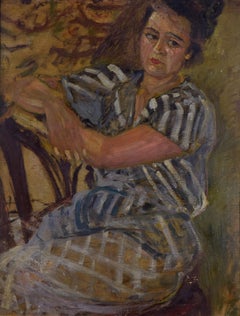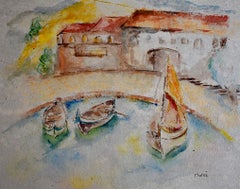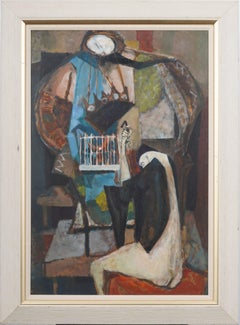Mela Muter Art
to
1
1
Overall Width
to
Overall Height
to
2
1
1
1
1
1
1
1
1
2
1
1
1
2
9,478
2,688
1,375
1,361
1
2
Artist: Mela Muter
Portrait of a Woman by MELA MUTER - Impressionist, Modern, Portrait, Oil
By Mela Muter
Located in London, GB
*UK BUYERS WILL PAY AN ADDITIONAL 20% VAT ON TOP OF THE ABOVE PRICE
Portrait of a Woman by MELA MUTER (1876-1967)
Oil on board
70.5 x 54 cm (27 ³/₄ x 21 ¹/₄ inches)
Signed lower le...
Category
20th Century Modern Mela Muter Art
Materials
Oil
Port in Saint Tropez - Watercolour and Ink - Polish Ecole de Paris
By Mela Muter
Located in London, GB
MELA MUTER 1876-1967
(Maria Melania Muter)
Warsaw 1876 - 1967 Paris (Polish)
Title: Port in Saint Tropez, 1920
Technique: Signed Watercolour and Ink on Thick Textured Card
Size: ...
Category
1920s Post-Impressionist Mela Muter Art
Materials
Ink, Watercolor
Related Items
America impressionist portrait young boy 1937 Modern Figurative Oil Painting
Located in Buffalo, NY
A fantastic modern portrait of a young boy. This work is signed what appears to be Paul Sellers and dated 1937, but we have not found information on the artist.
The work dated 1936...
Category
1930s American Modern Mela Muter Art
Materials
Oil, Board
Vintage American Modernist Surreal Figural Nude Portrait Large Framed Painting
Located in Buffalo, NY
Antique American modernist nude portrait oil painting. Oil on board. Framed. In excellent original condition. Handsomely framed in a modern molding. Excellent condition, ready to ...
Category
1950s Modern Mela Muter Art
Materials
Oil, Board
$775
H 43 in W 32 in D 2 in
On the Beach. Woman Reading. Mid-Century Chicago Modernist Oil Painting.
Located in Marco Island, FL
Chicago Modernist, William Schwartz, painted this intimate painting of a woman reading titled On the Beach. He studied at the Art Institute of Chicago shortly after emigrating to th...
Category
Mid-20th Century American Modern Mela Muter Art
Materials
Canvas, Oil, Board
$6,500
H 21.88 in W 17.38 in D 2 in
A 1926 Watercolor of Ships at a Dock, Chicago River by Artist Harold Haydon
By Harold Haydon
Located in Chicago, IL
A 1926 watercolor of ships at a dock by artist Harold Haydon. Image size: 9" x 12". Framed size: 14" x 18". Provenance: Estate of the artist.
Harold Emerson Haydon was born in...
Category
1920s Post-Impressionist Mela Muter Art
Materials
Paper, Ink, Watercolor
“Strolling along the Seine, Paris”
By Guy de Neyrac
Located in Southampton, NY
The artwork is double matted with an antique style contemporary gold leaf gallery frame in fine condition. Overall framed measurements are 24 by 31 inches. Provenance: A Sarasota, Florida collector.
Guy de Neyrac was born in France in 1900 and is widely known for his impressionistic watercolor and pen drawings of Paris...
Category
1940s Post-Impressionist Mela Muter Art
Materials
Ink, Watercolor, Archival Paper
$1,280 Sale Price
20% Off
H 16.5 in W 23.25 in D 1 in
accordionist with pipe oil on board painting modernism art
Located in Sitges, Barcelona
Albert Roca (1945) - accordionist with pipe oil on board painting
Medidas óleo 47x34 cm.
Medidas marco 62x48 cm.
Painter of landscapes and figures, in who...
Category
1990s Modern Mela Muter Art
Materials
Board, Oil
$708 Sale Price
50% Off
H 18.51 in W 13.39 in
An Ideal Head of a Woman
By Alfred Henry Maurer
Located in New York, NY
In the tradition of Modigliani, Maurer's depictions of women are expressive and lively. America had very few modernists who painted in this manner but Maurer is famous for exactly t...
Category
1920s American Modern Mela Muter Art
Materials
Gesso, Oil, Board
Pere Creixams Spanish Woman, Oil on Canvas
By Pere Créixams Picó
Located in Saint Amans des cots, FR
Oil on canvas by Pere Creixams Pico (1893-1965), School of Paris, ca.1920. Beautiful Spanish woman. Provenance: Charpentier Gallery, 76 rue du Faubourg Saint Honore, Paris (Sotheby's...
Category
1920s Modern Mela Muter Art
Materials
Canvas, Oil
$4,000
H 24.81 in W 19.49 in D 2.96 in
Soldier. 1950. Cardboard, author technique, 39, 5x20 cm
Located in Riga, LV
Soldier. 1950. Cardboard, author technique, 39,5x20 cm
Artwork depicts a soldier in motion. Author has used a mixed media technique on cardboard. Both the soldier himself and the fe...
Category
Mid-20th Century Modern Mela Muter Art
Materials
Oil, Paint, Mixed Media, Cardboard, Stencil, Other Medium
$566 Sale Price
20% Off
H 15.56 in W 7.88 in D 0.79 in
L'Ile des Oiseaux by Paulémile Pissarro - Landscape watercolour
By Paul Emile Pissarro
Located in London, GB
L'Ile des Oiseaux by Paulémile Pissarro (1884-1972)
Watercolour and charcoal on paper
23 x 31 cm (9 x 12 ¹/₄ inches)
Signed lower right, Paulémile Pissarro
Provenance
Private collec...
Category
20th Century Post-Impressionist Mela Muter Art
Materials
Paper, Ink, Watercolor
$4,800
H 9.06 in W 12.21 in
Provence Gnarled Trees Mid 20th C.French Post Impressionist Signed Painting
Located in Cirencester, Gloucestershire
Provence
Jean La Forgue (French 1901-1975)
signed watercolour, ink on paper, mounted in a card frame
inscribed verso
card frame: 17 x 22 inches
painting: 12 x 17 inches
provenance: ...
Category
Mid-20th Century Post-Impressionist Mela Muter Art
Materials
Ink, Watercolor
$557 Sale Price
30% Off
H 17 in W 22 in
The Old Farm Cart 20th Century French Impressionist Signed Painting
Located in Cirencester, Gloucestershire
Jean La Forgue (French 1901-1975) signed watercolour, ink on paper, mounted in a card frame
inscribed verso
card frame: 12 x 16 inches
painting: 9 x 13 inches
provenance: the artists...
Category
Mid-20th Century Post-Impressionist Mela Muter Art
Materials
Ink, Watercolor
$557 Sale Price
30% Off
H 12 in W 16 in
Mela Muter art for sale on 1stDibs.
Find a wide variety of authentic Mela Muter art available for sale on 1stDibs. You can also browse by medium to find art by Mela Muter in paint, ink, oil paint and more. Much of the original work by this artist or collective was created during the 20th century and is mostly associated with the Post-Impressionist style. Not every interior allows for large Mela Muter art, so small editions measuring 22 inches across are available. Customers who are interested in this artist might also find the work of Spencer Pryse, Charles Picart le Doux, and Jean-François Baudoin. Mela Muter art prices can differ depending upon medium, time period and other attributes. On 1stDibs, the price for these items starts at $10,193 and tops out at $12,000, while the average work can sell for $11,097.


